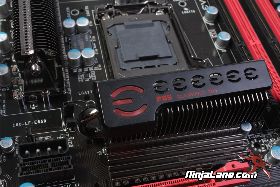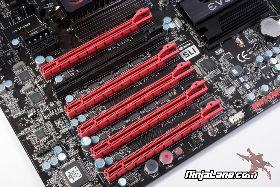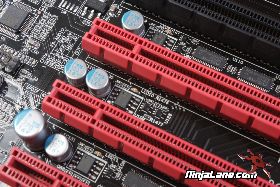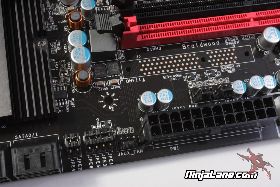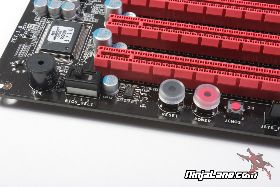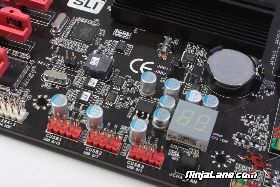After careful consideration I have decided to transfer all hardware review activities to a new domain. I purchased Hardwareasylum.com in 2012 and have been working hard to build a new and improved Ninjalane on that domain. If you are reading this you have reached one of the archived articles, news, projects and/or reviews that were left behind during the site migration.
Please update your bookmarks and be sure to visit the new and improved Ninjalane at Hardwareasylum.com
EVGA P55 Classified 200 Motherboard Review
Author: Dennis Garcia
Published: Friday, April 09, 2010
Board Layout and Features Cont.
To ensure there is plenty of PCI Express bandwidth, the P55 Classified features the nVidia NF200 chip. The new controller chip adds an additional 16x PCI-e lanes to the motherboard, but does so by borrowing bandwidth from the 16x supplied by the CPU. In the end, it works out to provide 8x PCI-e bandwidth to every red slot on the motherboard, and in some cases, 16x if certain slots are empty.
Unlike most mainstream motherboards, the P55 Classified doesn't come with any legacy PCI slots. Instead, you get six 16x PCI-e slots and a single 1x slot located towards the top. The layout fully supports multi-GPU video card configurations dual slot coolers.
When running more than one video card, you may encounter an instance where you need to remove one of those cards for testing purposes, or maybe run a two-card SLI benchmark if you normally have three cards installed. Usually, to do this, you would need to remove the topmost card first and work your way down to the card in question. With the P55 Classified, you get the option to disable any of the PCIe slots by simply removing a jumper.
When running more than one video card, you may encounter an instance where you need to remove one of those cards for testing purposes, or maybe run a two-card SLI benchmark if you normally have three cards installed. Usually, to do this, you would need to remove the topmost card first and work your way down to the card in question. With the P55 Classified, you get the option to disable any of the PCIe slots by simply removing a jumper.
Each of the 16x slots comes with a corresponding LED which indicates if the slot is enabled or not. Fundamentally, having LEDs near the PCIe slot seems like a good idea. However, dual-slot video cards have a tendency to cover them up.
The disable jumpers are a great feature which helps to save time when benchmarking so you can concentrate more on submitting scores or breaking records, and less time worrying about tearing everything down to determine what card may have gone bad or isn't overclocking as well.
The disable jumpers are a great feature which helps to save time when benchmarking so you can concentrate more on submitting scores or breaking records, and less time worrying about tearing everything down to determine what card may have gone bad or isn't overclocking as well.
EVGA is one of the few companies that allows you to run up to three different BIOS versions at once on the same motherboard. Simply move the BIOS selector switch to move between the different versions. Nearby, you will find the debug LED and additional USB and Firewire connectors.

